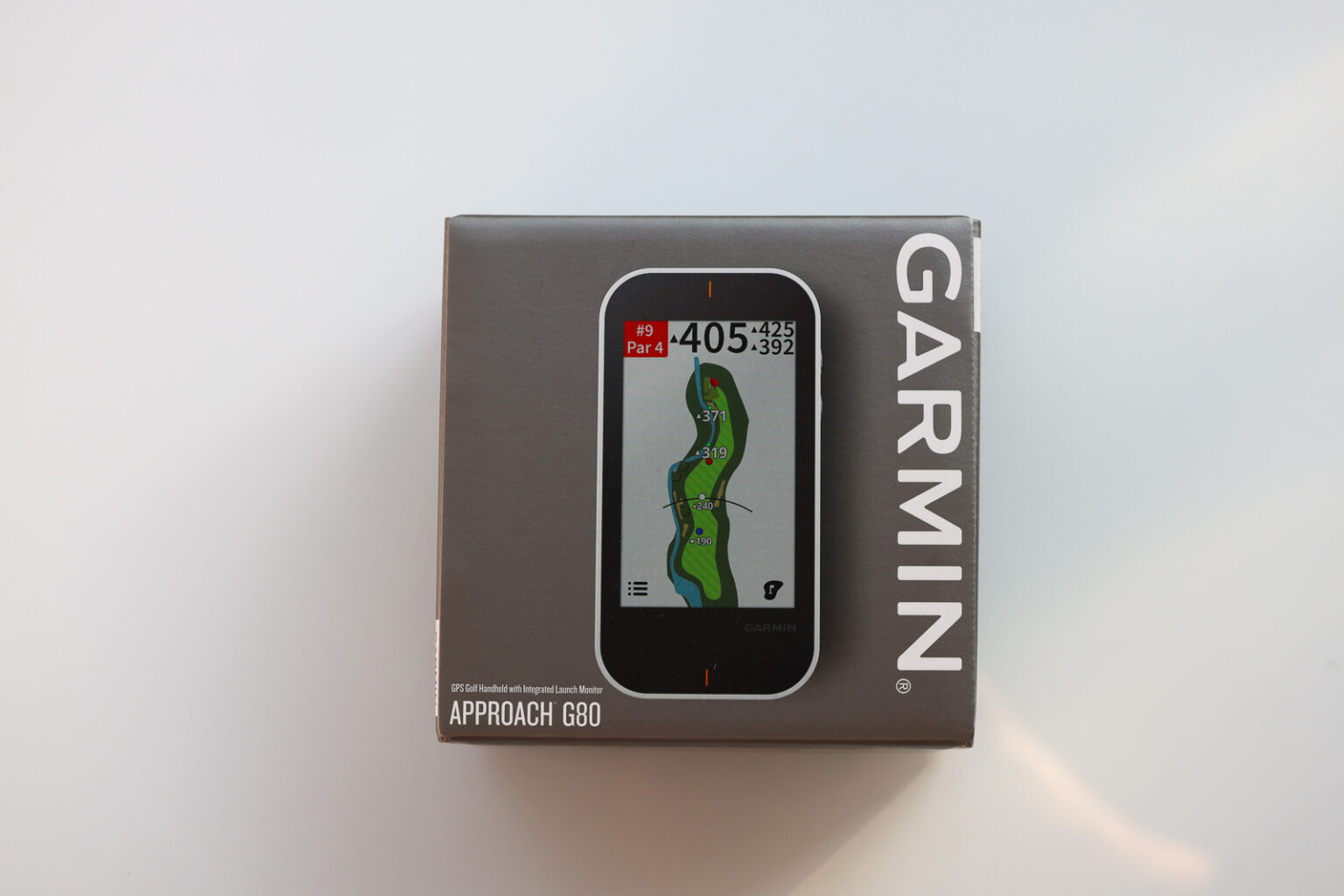As I’ve become more familiar with the golf tech world over the years, there’s one product I never quite understood: the Garmin Approach G80.
I’ve always thought it was just a hand-held GPS – an expensive one at that, considering it costs $500.
With all of the smartphone apps out there that can essentially do the same thing, I just didn’t quite understand why this product was so expensive.
And then I found out.
It’s because the Approach G80 is far more than just a golf GPS. It’s a launch monitor. It’s a simulator (kind of). And it may just be the ultimate “jack of all trades” tool to keep in your bag.
In this Garmin Approach G80 review, I’m going to show you why it’s one of the most unique devices in golf. We’re going to look at the pros and cons of it, and help you figure out if it’s worth picking one up to keep in your golf bag.
March 2025 Update: Also Consider the Approach G20
Over 5 years since the G80 was originally released, and 2 years since I did my review, Garmin is still selling the G80.
And the good news is that for the right use case, it’s still worth buying!
But if you want to save a few bucks, don’t need a color screen, and like the idea of unlimited batter life – you might also consider the brand new Garmin Approach G20.
It’s not as full featured as the G80, but it has some quality of life improvements, and is a rock solid unit.
First Impressions of the Garmin Approach G80
About 2 months ago I was watching a video done by Gabe of Let’s Play Thru. He was testing out a new club on the course. For each shot, he had this portable launch monitor that he was just setting down next to the ball, hitting, and getting seemingly accurate yardages from.
What?!
Every launch monitor I’ve used requires way more work than that if you’re actually trying to get usable numbers.
As I looked closer, I realized he was using the Garmin Approach G80.
This was when I started to get really curious and knew I had to get my hands on one of these.
Out of the box, the G80 feels just like every other Garmin Approach product I’ve used. Same gray box, similar packaging, very well done.
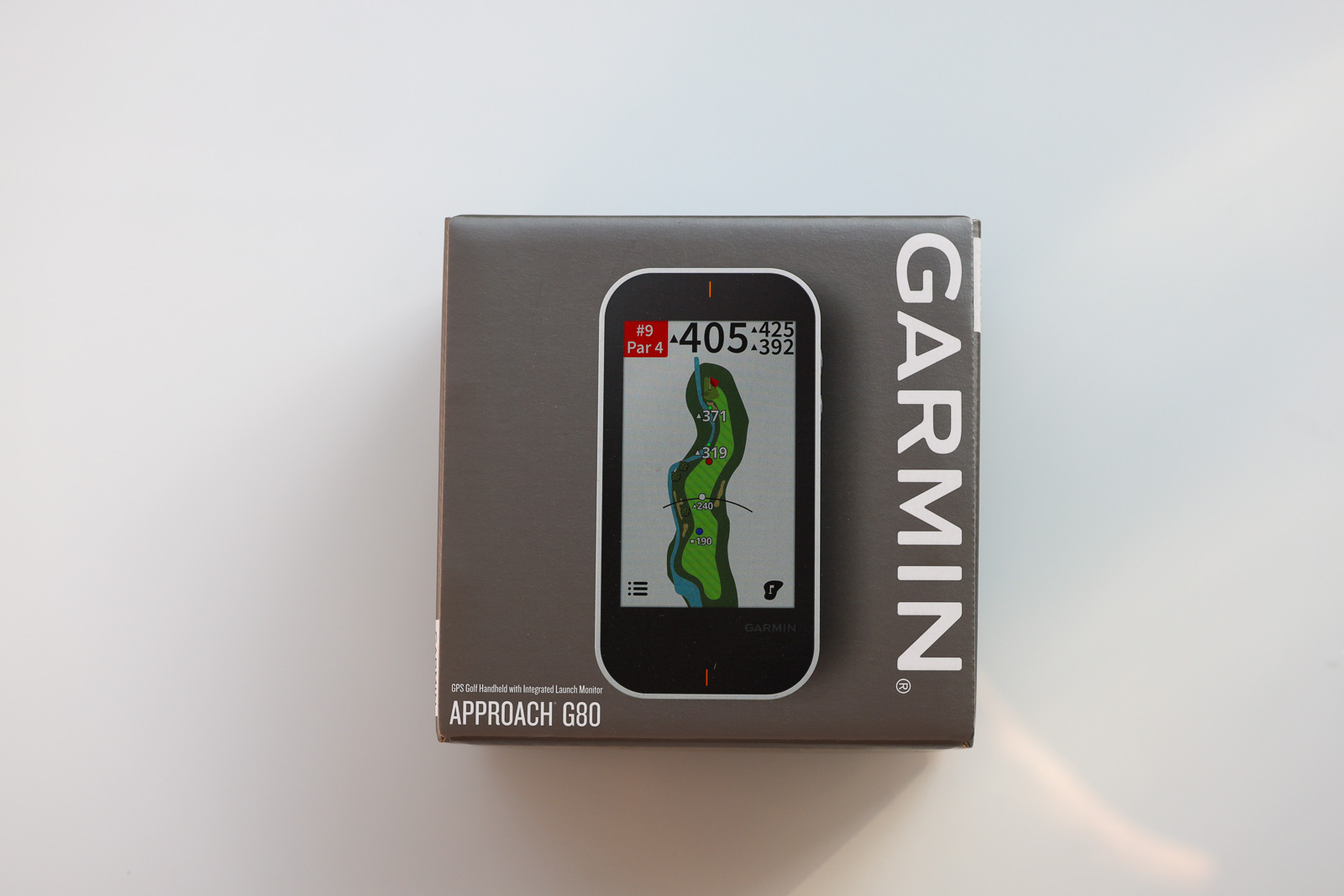
The packaging is nothing overly flashy, but the consistency of it gives you confidence in the product you’re opening.
The device itself feels very well made, being roughly 4 inches long, 2 inches wide, and 1 inch thick.
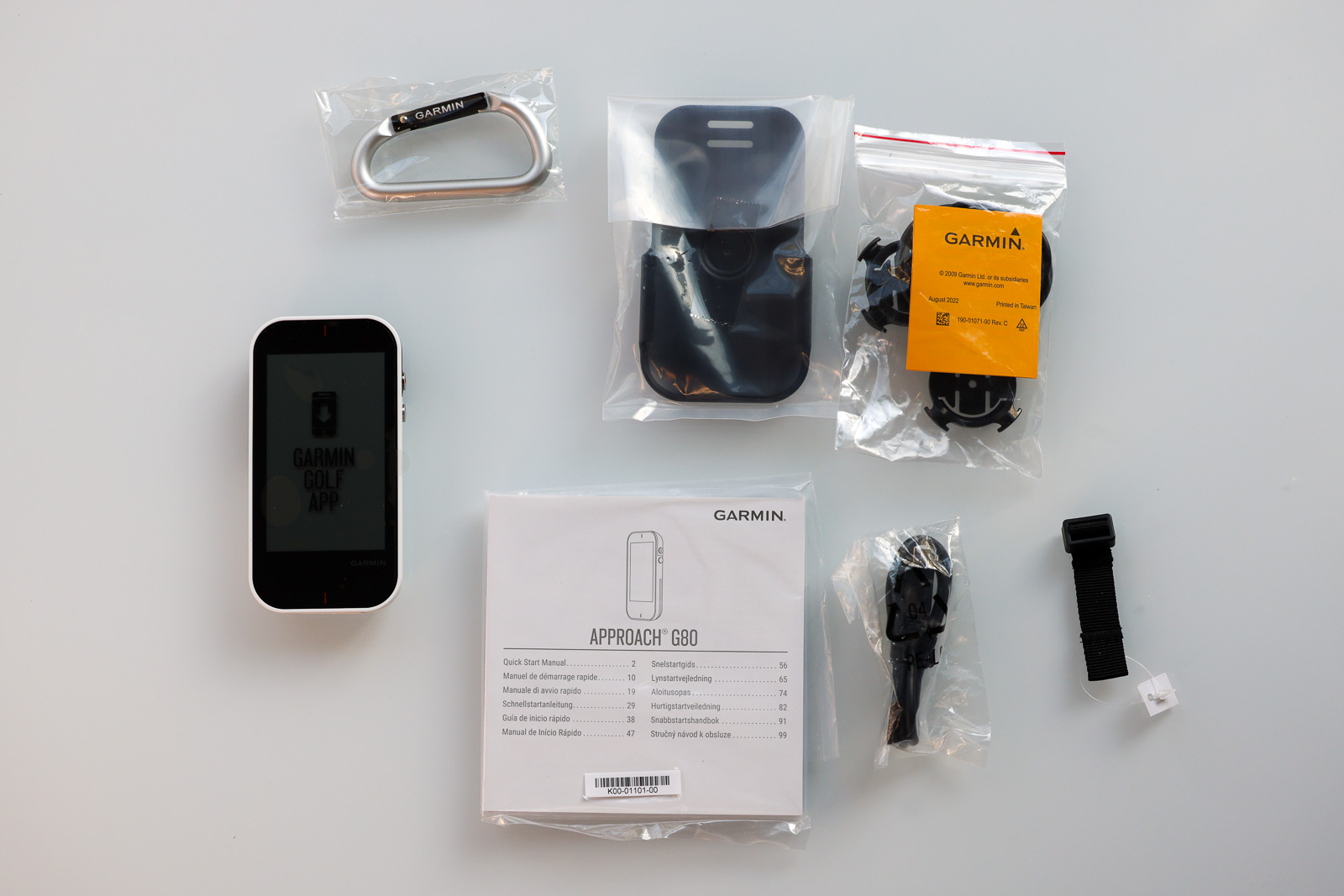
One of the first things I noticed was that it came with a series of rubber bands and clips, that seemed – kind of weird.
I quickly realized this is what you’ll need to use in order to attach it to a golf cart.
If there’s any product that seems primed to have a magnet to attach to the cart – this is it. As the series of clips they use for doing this is cumbersome at best.
I assume the reason it wasn’t included was that this product was developed before the craze in rangefinders or speakers with built-in magnets. Either that, or there’s a technical reason and the magnet may interfere with launch monitor data.
In any case, it would have been nice to see.
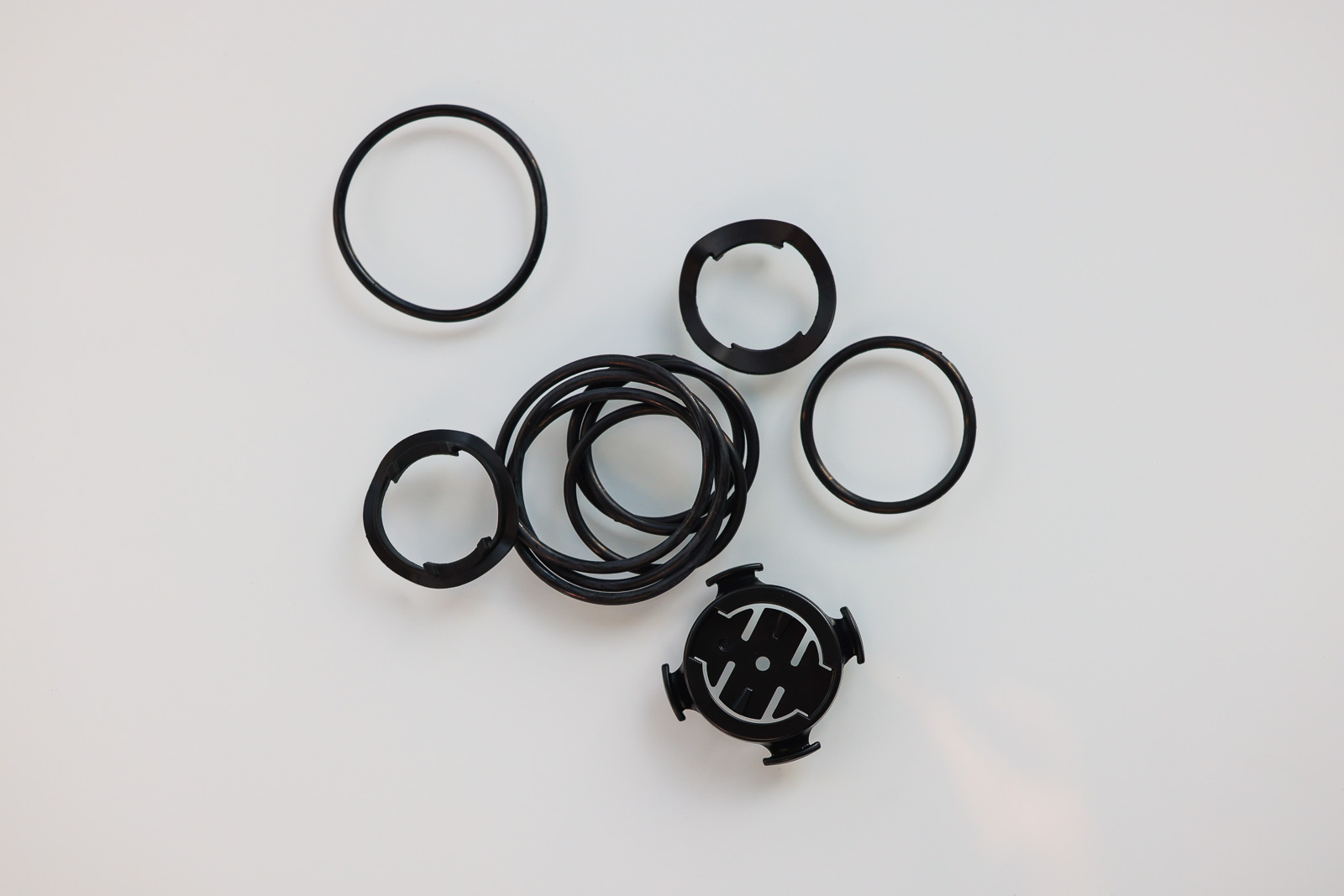
The screen is a transflective display that is similar to that of the Approach S62 or Approach S42 GPS watches. While it’s certainly not as bright or as crisp as the AMOLED display found in the new Approach S70 watch, it gets plenty bright, and in some ways, these displays are easier to see in bright sunlight than their OLED counterparts.
I’d still love to see an updated version of this come with the new screen, however.
The case fits snugly over the device, and the attached carabiner is perfect for the walking golfer who just wants to clip it to their bag.
But how does it perform, and what makes it worth the $500 price tag? Let’s find out.
Using the Garmin Approach G80 for GPS
Let’s start out with the most obvious use case of the Approach G80, using it as a golf GPS.
Like all of Garmin’s golf products, the G80 pairs with the Garmin Golf app to provide additional features to the device.
This is great if you want to keep your scores within the app, or if you have a Garmin Golf membership and want access to green contour data (more on that below).
It’s very easy to pair, and I was ready to rock in under a minute since I already had a Garmin account setup.
As you’d expect from Garmin, all of the GPS data on the G80 was fantastic.
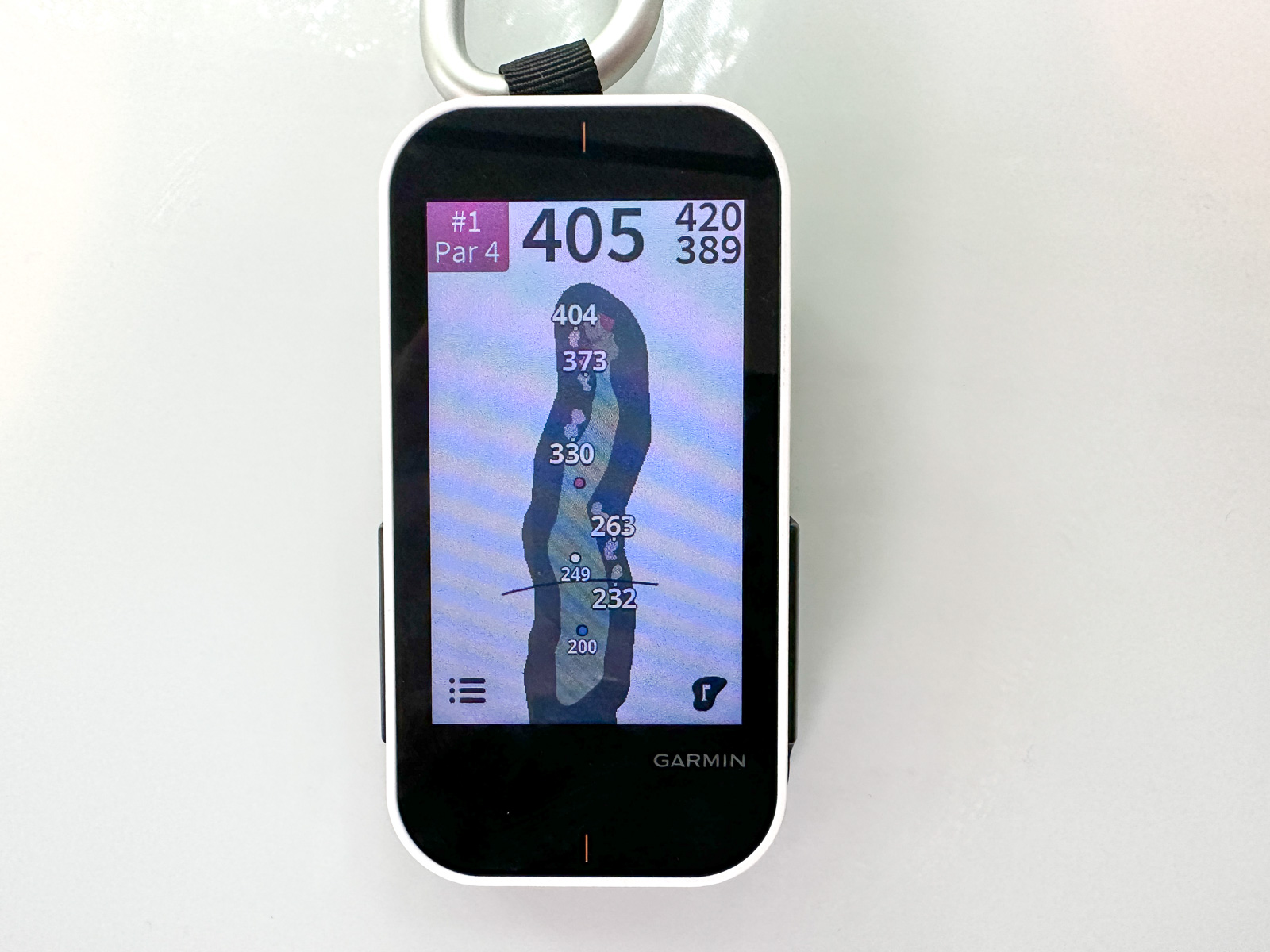
This is specifically what Garmin is known for, and in two rounds using the G80, I’ve found all of the distances to be dead on.
The 3.5 inch screen is touch-sensitive, so it’s super easy to select any spot on the hole you’re on and see how far your drive was, get layup and hazard distances, or distances to various points on the green.
The screen is quite responsive, but not quite to the level of a new smartphone.
As I mentioned above the G80 has a transflective display, which does the job and works well in bright light, but it’s a far cry from the crispness you get from an OLED or Retina screen.
You can easily move the pins in green view, so if you have a pin sheet, and can accurately set where they are – this is a welcome feature.
You can alternatively select a “big numbers” view if you want to make it very clear how far away the front, back, and center of the green is.
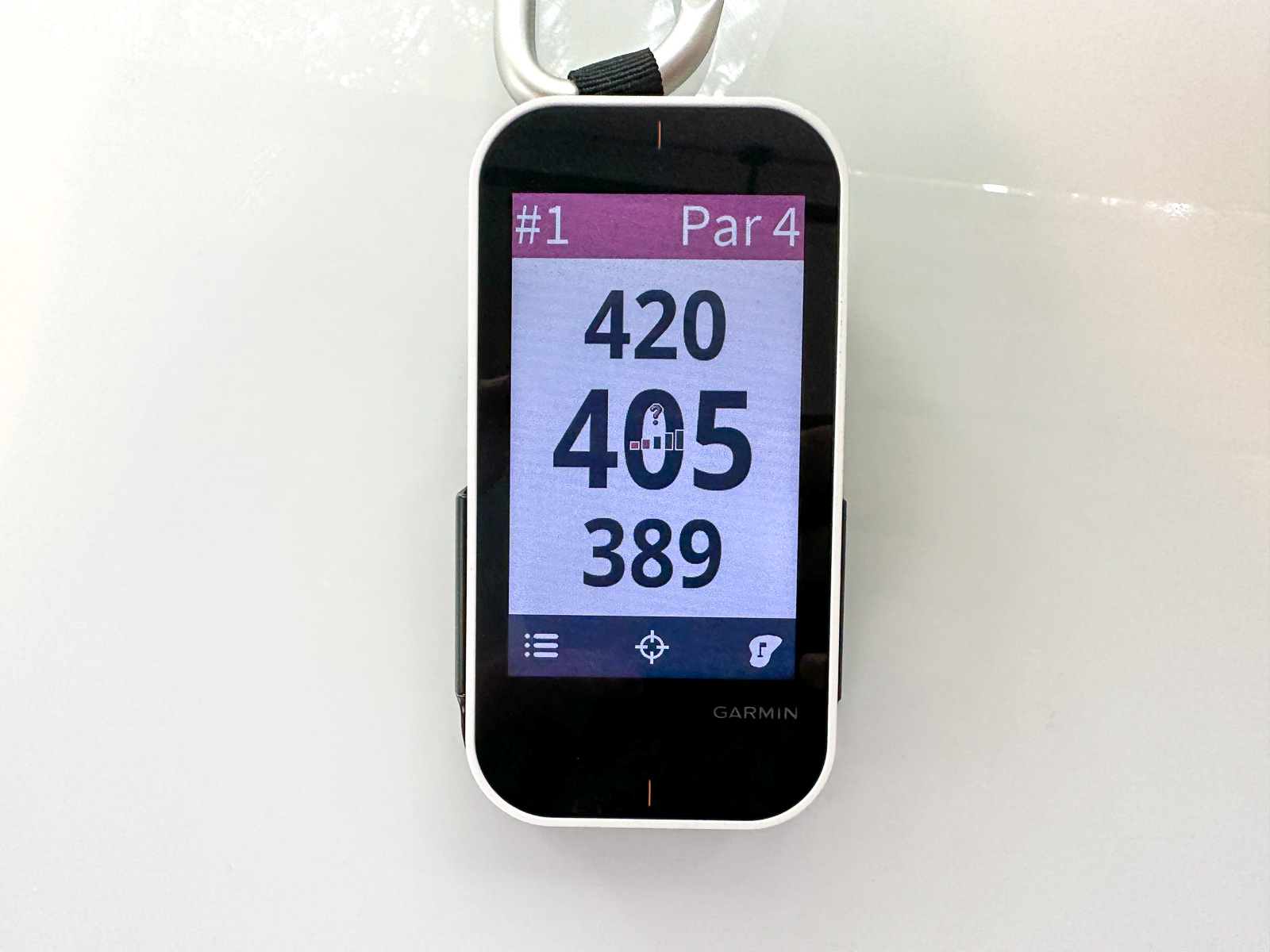
The big screen makes scoring very easy, and it also has scoring features for both Stableford and match play – which is something I’m happy to see Garmin has integrated into many of their products.
I found it even easier to navigate than many Garmin smartwatches, simply because the size and simplicity of it makes everything feel very intuitive.
But honestly, $500 is a lot to spend on a handheld GPS. For instance, the Arccos Golf app provides more AI and machine learning data, leverages the beautiful screen on your Apple or Android device, and has shot tracking.
For even less money than that, you just pick up Golfshot GPS and get a very dialed-in GPS experience.
No, the handheld GPS of the Approach G80 is almost just a bonus feature in my mind. The real star here is the versatility it provides as a GPS and a launch monitor.
The Approach G80 is the only product of it's kind in golf. If you're looking for the easiest-to-use launch monitor for practice before your round, AND a GPS during your round. Look no further.
Is the Garmin Approach G80 a Good Launch Monitor?
When it comes to Garmin launch monitors, the Approach R10 has stolen the show. It was released about a year after the G80, and at under $600, it provides an insane number of features and great accuracy considering its price.
The Approach G80 is also a launch monitor, and its utility resides in its ease of use.
Even though the Approach R10 is fast and easy to set up as it relates to launch monitors, you still have to align it properly, pair to to the app, and go through a few extra steps to get it working.
The G80 is different.
On the back of the G80, there’s a round imprint that’s the exact size of a golf ball.
To use the Garmin Approach G80 you simply place it a couple feet in front of you on the range, rest it on top of a golf ball, and you’re good to go.
Less than 30 seconds and you’re set up for practice.
In its most basic function as a launch monitor, the Approach G80 will display information for:
- Estimated Carry
- Estimate Carry + Roll
- Smash Factor
- Tempo
- Clubhead Speed
- Ball speed
Of that information, it is directly measuring:
- Ball speed
- Club speed
- Backswing time
- Downswing time
The additional data points are then calculated and estimated based on these.
I honestly, expected the accuracy of this device to be quite poor.
Considering you just set it beside you anywhere you go, and swing – I figured a device with that little required in terms of calibration would struggle.
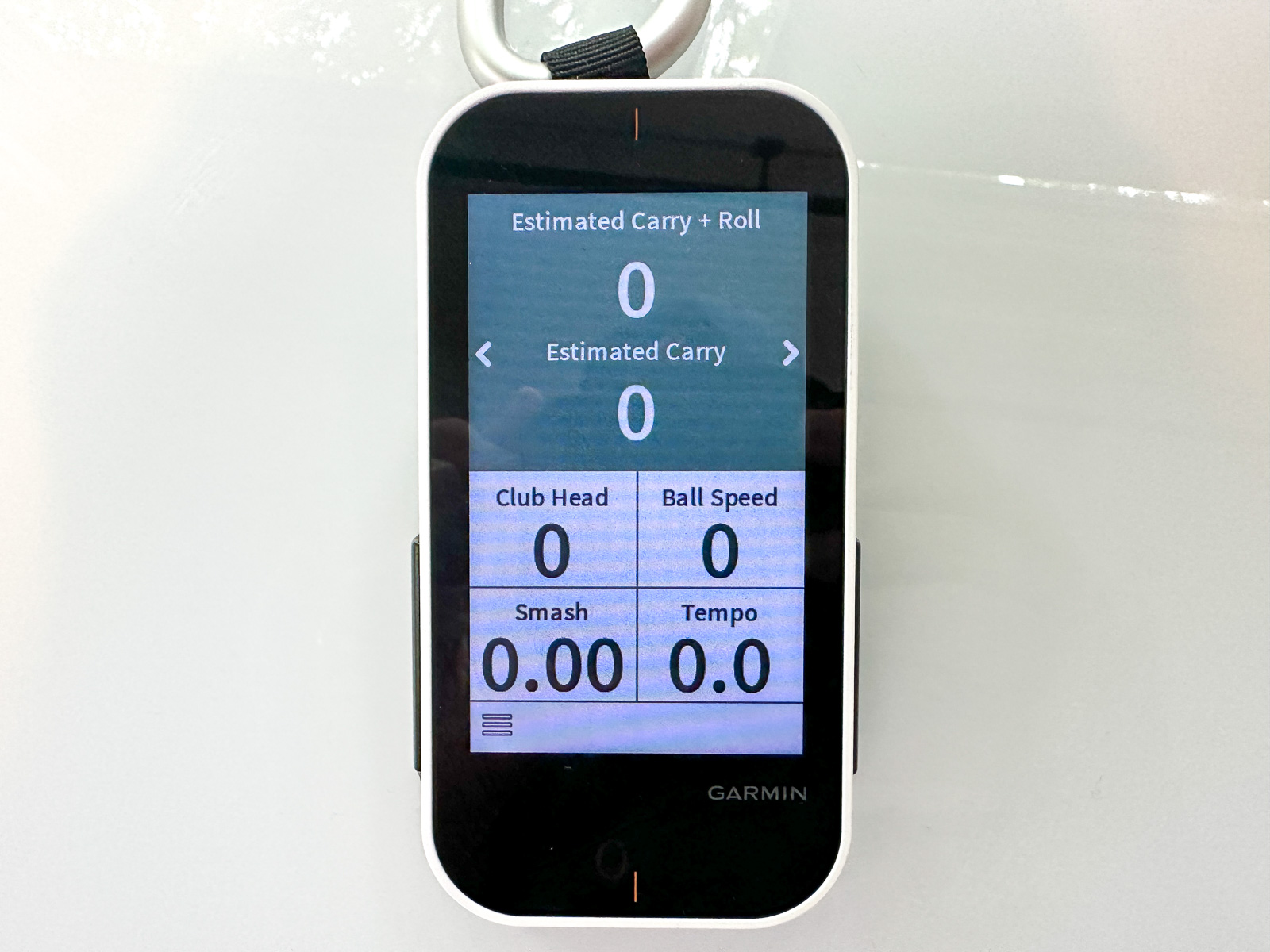
But honestly? It’s really solid for what it is.
I found my well-struck shots to give me measurements within 1-3 yards of my FlightScope Mevo Plus from wedges all the way up through driver.
The anomaly here is if I had a really bad slice or mishit, then the distance would be off pretty significantly.
But as long as it was a relatively well-struck shot, the accuracy of the launch monitor feature was surprisingly good.
This is what I was hoping to see, because this is one of the only launch monitors I’ve used that is truly convenient for using as a warmup before a round of golf.
Any of the app-based devices, are just a little too cumbersome when you only have 15 or 20 minutes before a round.
And other similarly priced models with built-in screens like the Swing Caddie SC300i are big enough, that you won’t want to keep them in your bag all round.
So having a launch monitor and a GPS all in one – all of a sudden becomes a very useful tool.
But the Approach G80 Gets Better…
As I continued to go through the G80 features on the range, I continued to be more and more surprised by how much they’ve packed into it.
There are a number of other modes that make this device both practical, as well as fun to use.
Using the G80 as a “Simulator”
Ok, calling it a “simulator” is a bit of a stretch, but the Approach G80 has the ability to play Virtual Rounds in the device.
This means that you can play any of the pre-loaded 41,000+ courses virtually on the range.
This works in a very similar manner to the Home Tee Hero feature of the Approach R10. And it’s so easy to use.
I’ve found myself actually working this into my pre-round process when I have the time. I’ll setup a virtual round on the course I’m preparing to play, and then I’ll “play” the first 3-4 holes of the course on the range.
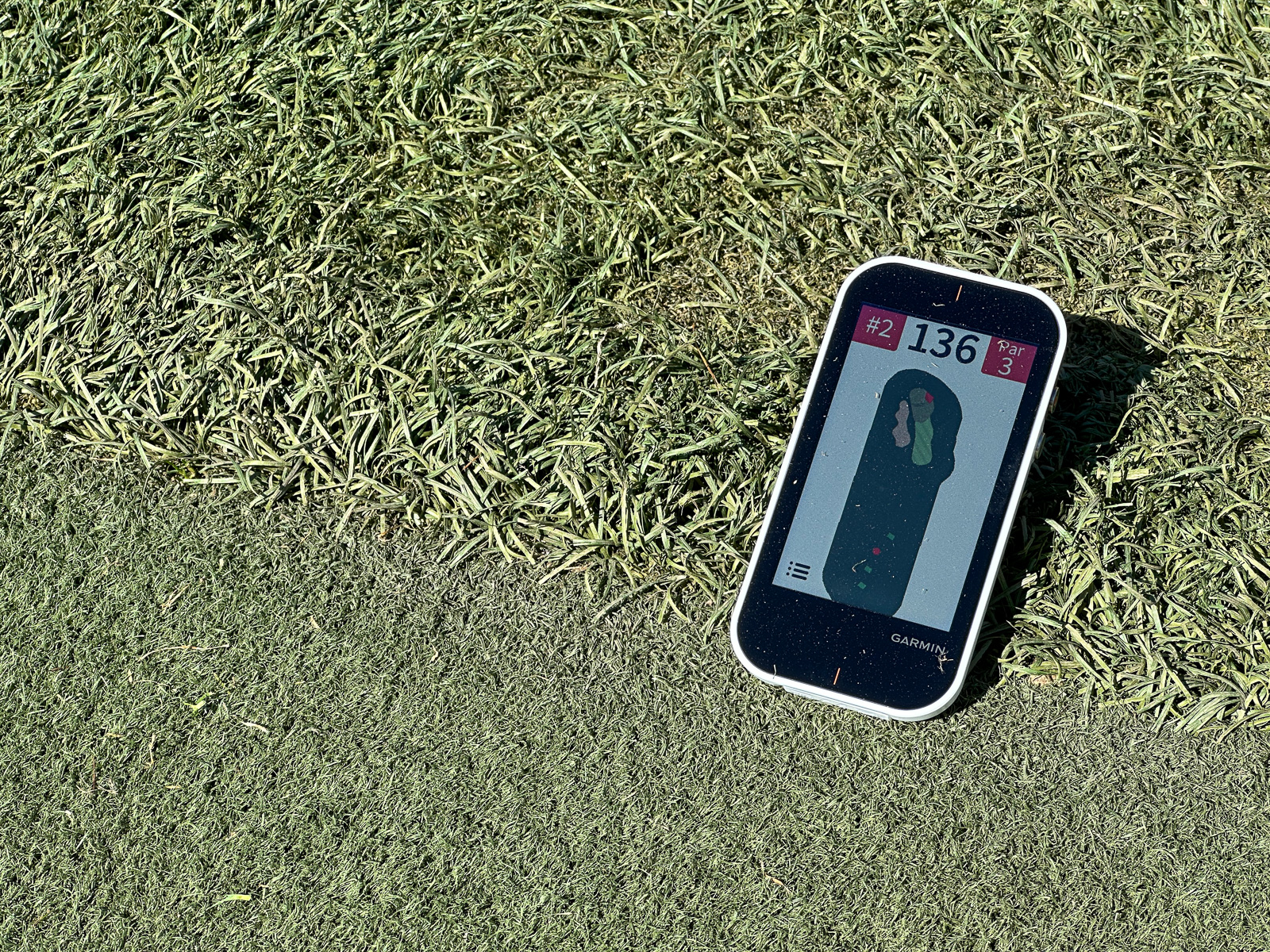
This allows me to practice the actual shots and strategy I’m about to hit and get my head in the round.
There’s no putting, instead, your number of putts is dictated by how close to the virtual pin your approach shot is.
When I got the G80, I didn’t know this feature was built in. It’s faster and easier to use than with any other launch monitor I’ve tested.
Practice Games
I’m not someone who generally likes to practice. I rarely will grind away on the range for hours. So when I am practicing, I’m always looking for easy ways to make it more fun.
There are a number of games built into the Garmin Approach G80 that allow you to do just that.
The primary mode allows you to set a distance and a club, and then try and get as close to the pin as possible over a series of 5 shots.
The closer you are, the more points you get.
Again, launch monitors like the Mevo Plus and the MLM2Pro each have similar features. But those, while more accurate, take much longer to set up and calibrate.
The G80 won’t provide as much shot data, and it won’t be as accurate and granular – it’s accurate enough for casual practice sessions, and the convenience of it will make it a better fit for a lot of people.
Tempo Training
There are a number of devices out there that can give you data on your swing tempo. The Blast Motion was one of the originals, and now it’s in golf watches like the Voice Caddie T9 and the new Approach S70.
But the G80 includes it without having to attach anything to your club or your body – which is nice.
Again, in the name of simplicity, everything in the G80 is easy to use, which makes you more likely to use it.
Garmin Golf Membership
Garmin has tried to simplify their golf offerings, by including one app that all of their golf products are compatible with. This generally works great. They’ve built a really solid ecosystem, and the more engrained you get in it, the more useful it becomes.
They’ve done something similar with their premium membership. One membership, one price, regardless of which devices you have.
The problem is, the Approach R10 is the one device that really benefits the most from the $10/month membership. It gives you the Home Tee Hero virtual rounds and extra storage for videos of your swing.
The only other feature this membership provides is Green Contour data. Devices like the Approach G80, Approach Z82 rangefinder, and Approach S70 watch all have the ability to display green contour data – but you’ll have to shell out for the membership to get it.
And considering that’s the only thing the Garmin Golf Membership gets you for these devices – that’s a lot of money to pay for one feature.
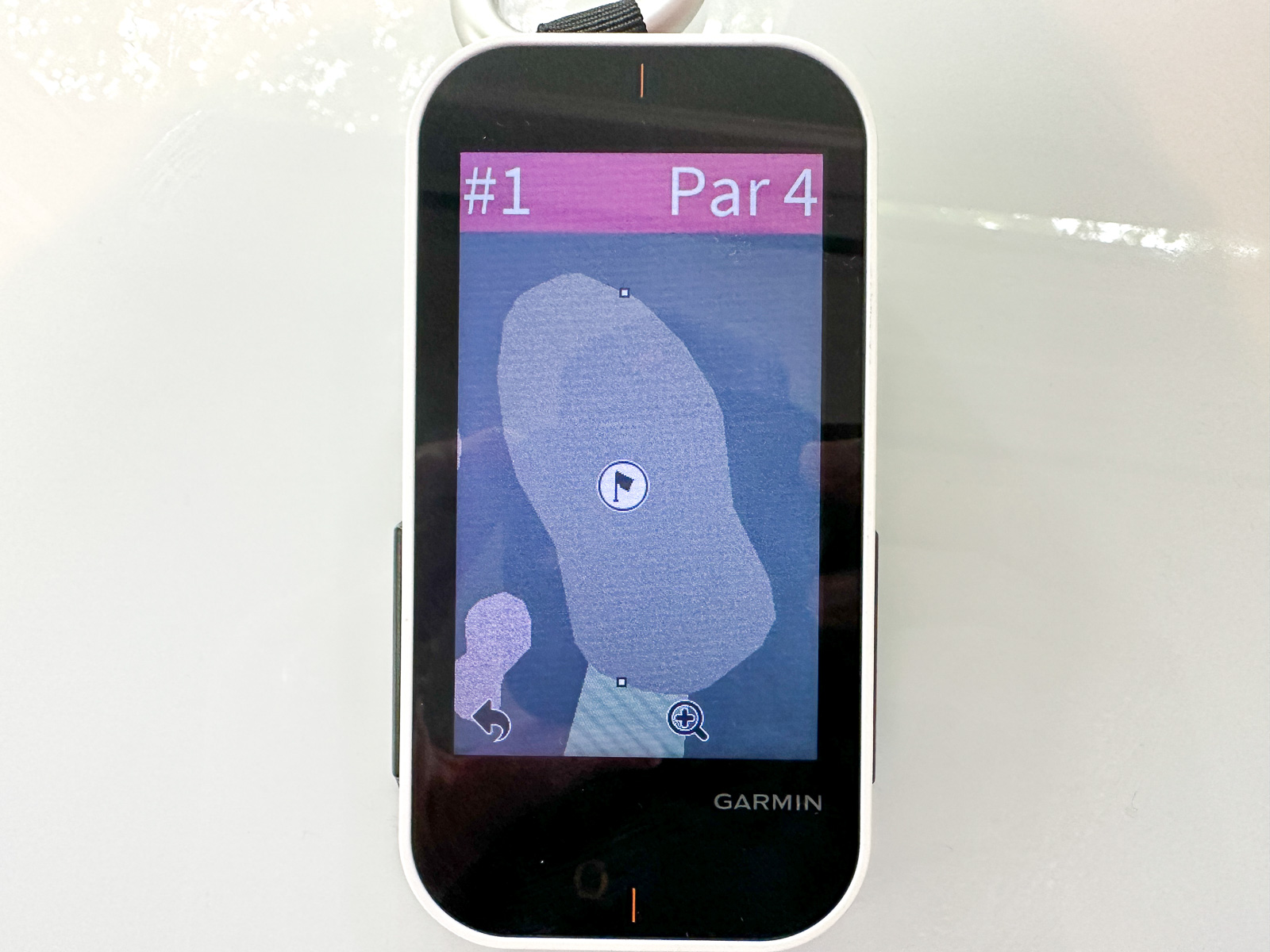
It’s too bad, also.
Because arguably the G80 is the device that’s the most well-positioned to benefit from Green Contours. The size of its screen makes it way easier to leverage the data, when compared to doing it on a golf watch.
Considering the G80 is already a very expensive device at $500, this feels like a feature that should be built in for free. Especially considering watches like the Voice Caddie T9 include it for no extra fee.
So while the Green Contour data is great, and the G80 is arguably the best way to use it, the extra fee is a bit of a bummer.
Worth noting though that the virtual rounds are included for no extra charge, which is a welcome feature.
Final Thoughts on the Garmin Approach G80
The Garmin Approach G80 is a tricky product because there really isn’t anything else out there like it.
And it’s expensive.
Is it the best and most accurate launch monitor out there? Definitely not.
Is $500 a lot of money to spend on a handheld GPS when your phone can do the same thing as well or better? Sure is.
Is it now over three years old, and likely do for an upgrade soon? Yep.
But where the magic of the Approach G80 lies is in its ability to do a little bit of everything, very well, and very quickly.
This is one of the only launch monitors I’ve found that you can truly pull out and immediately use with solid results from anywhere.
The fact that it sits right in front of you, rather than 6-7 feet behind you is also huge because you can see the screen right in front of you at all times.
I’m honestly surprised by how much I enjoy the G80.
The problem is, it’s a niche person who will be willing to spend $500 on what it does.
If you’re looking to buy a launch monitor for detailed practice sessions? You can get far more data for around the same money by going with a Garmin R10, Voice Caddie SC4, or Rapsodo MLM2Pro.
If you want a handheld GPS, most of us will just use an app on our phone.
But if you’re willing to spend a little coin on one of the most convenient products in golf, I don’t think you’ll be disappointed with the G80.
I’ve found myself using it more than most of the other launch monitors I have, simply because there is zero friction in setting it up to use in a pre-round practice session.
The Approach G80 is the only product of it's kind in golf. If you're looking for the easiest-to-use launch monitor for practice before your round, AND a GPS during your round. Look no further.
This page contains affiliate links. This means that if you click a link and buy one of the products on this page, I may receive a commission (at no extra cost to you!) This doesn’t affect our opinions or our reviews. Everything we do is to benefit you as the reader, so all of our reviews are as honest and unbiased as possible.
Recent Updates:
March 11, 2025: Added reference to the new Approach G20 GPS device.

